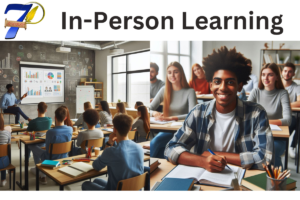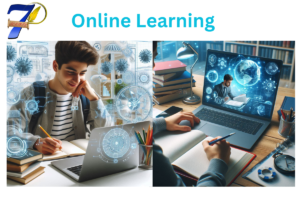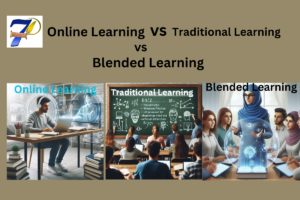In this rapidly growing world, with rest things, learning methods are also advancing quickly. We had already talked about different types of learning in our previous posts. In this post, we will discuss the most advanced method of learning. Yeah! In this post, we will know what blended learning is, the difference between the rest methods of learning, and its pros and cons. So without any delay, let’s get into it.
Introduction:
Blended learning is the combination of online learning and traditional in-person learning. It combines online learning with traditional face-to-face learning. A teacher should have face-to-face interaction with students, and students should have face-to-face interaction with other students and with the teacher. This type of learning can be done in any physical classroom or at home, but there must be face-to-face interaction.

In-person learning:
This is the traditional way of learning in which students learn from a teacher by appearing physically in the classroom. Appearance of both the teacher and students is mandatory. This type of learning is also known as offline learning or traditional learning.

Online Learning:
Learning by using technology is known as online learning. In online learning the student learns through different websites or applications. It is completely virtual and no in-person learning is involved. There is no need for a physical classroom for learning. Face-to-face interaction is also not necessary in this type of learning.

Explanation:
Blended learning possesses both online learning and in-person learning. Students may be at home but feel like, they are in the classroom since students can interact with the teacher and classmates. The student can ask the teacher questions and vice versa. Everyone can share their point of view directly. It combines the features of both online and in-person learning.
According to research, blended learning is more effective than in-person learning. This is due to its flexibility, accessibility, engagement, individual learning, and self-paced learning. It also includes assignments, quizzes, and much more as in-person learning is also a part of it.
Difference between Blended, Online, and In-person learning:
This table will help to understand the major differences between blended, online, and in-person learning:
| Sr.No. | Features | In-person Learning | Online Learning | Blended learning |
| 1. | Physical Appearance | Yes | No | Both |
| 2. | Flexibility | Limited | More Flexible | Flexible |
| 3 | Interaction | Yes | No | Yes |
| 4 | Self-Learning Pace | No | Yes | Yes |
| 5 | Availability | Limited | Every-Time | Both |

Advantages of Blended learning:
As it comprises both in-person and online learning it has a lot of advantages as compared to others. A few of them are mentioned below:
- Availability: After attending the class, students can revisit the website(or the tool that is being used) anytime and revise when needed. This feature is not available in in-person learning.
- Accessibility: It provides more accessibility, specifically for those students who are unable to attend physical classes. It is also a very good opportunity for disabled students.
- Effective Learning: Students can learn at their own pace, they can revise the whole lecture anytime anywhere, and they can skip those parts that the student thinks are easy or boring.
- Social Interaction: Aa students can be assigned group tasks, and enroll in other different activities which can improve the interaction between students and teachers, which is missing in online learning.
- Better Engagement: As it combines in-person learning and online learning, that’s why it can make it more engaging and interesting.
- Cost-Effectiveness: It reduces the cost of physical classes, other necessary tools and materials, student expenditure, and much more.
- Enhanced Collaboration:
Disadvantages of Blended Learning:
With many advantages, it has some disadvantages as well. A few of them are the following:
- Inequality: There is a chance of inequality between those students who have access to the resources for being part of blended learning and those who don’t. It will also be between those students who are good at using the internet and those who are not very familiar with the internet.
- Lack of Social Interaction: If the student is not present in any physical classroom it may result in less interaction between students and the teacher as compared to in-person learning.
- Technical difficulties: If the teacher or the students are facing some kind of technical issue like internet connectivity, then it can result in a loss of class.
- Potential for Cheating: In blended learning, there is a potential for cheating as the teacher or student may not physically appear in the class.
- Technological Requirements: The teacher or students (if not present in the physical classroom) may require good connectivity to the Internet, computer or mobile phone, webcam, projector, headphones or earphones, and some specific software is required for blended learning.
Conclusion:
In summary, blended learning combines traditional or in-person learning and online learning. It has revolutionized the way of learning. It has a lot of benefits over rest methods of learning. It contains most of the advantages of rest methods (in-person and online learning) i.e. it is more engaging, more effective, cost-effective, etc.
With benefits, we have to face numerous challenges as well such as technical faults that may occur in malfunctions, requirements of technology (fast internet, computer or mobile, projector, etc.), inequality, and much more.